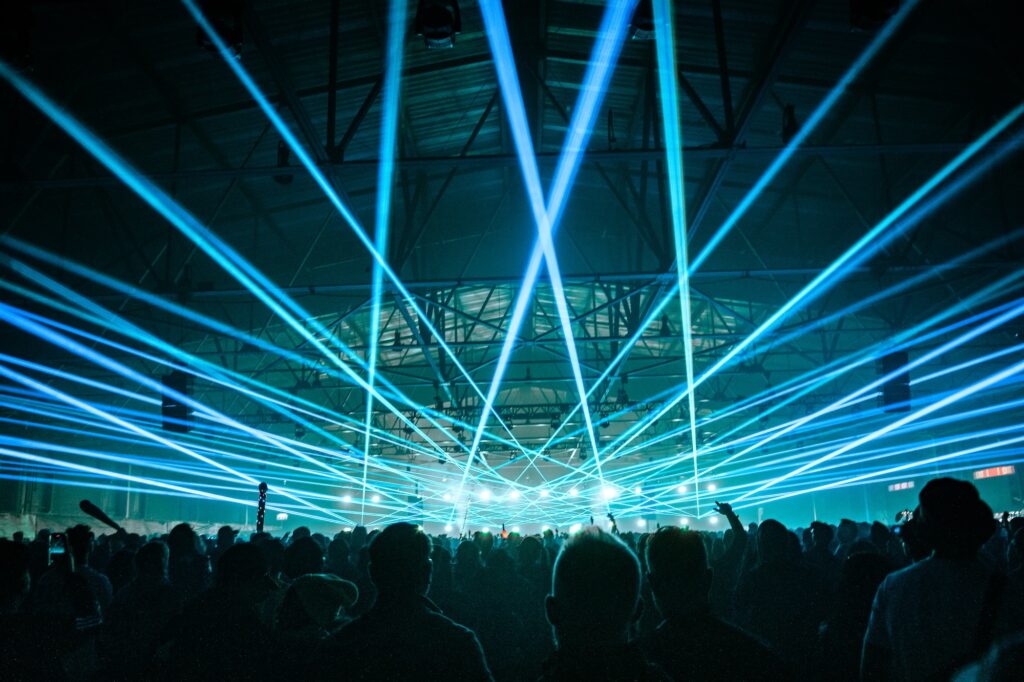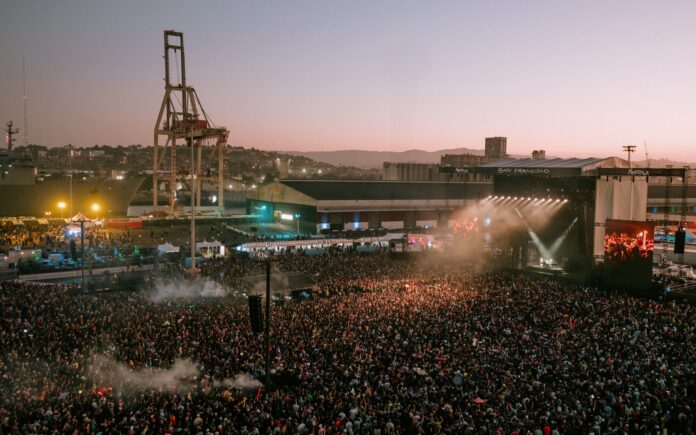From the minute I walked into Portola Music Festival on Pier 80, I could barely fire off a text message all weekend long. It didn’t matter if I was on iMessage or trying to circumvent it by sending an SMS instead. It didn’t matter if it was Saturday or Sunday, VIP or GA area, or which of the four stages I was at, poor cell service made texting damn near impossible for everyone who wasn’t behind the scenes.
It’s a strange wave of emotions when you realize that a fairly straightforward festival link up might not be a possibility anymore. Those friends you planned on kicking it with this weekend at Portola? Far from a certainty. At first I was pissed. Year one of Portola had similar issues, which event producer Danny Bell of Goldenvoice told 48Hills was supposedly being addressed in year two. Now in year three, it felt like being stuck in square one. And as I slowly accepted these circumstances as the weekend went on, I started to wonder if maybe the experience was better this way to begin with?
I grew up going to warehouse raves and massives in the early aughts and this was standard operating procedure in those days, because we didn’t have cellphones to speak of. So who you went to the function with, is who you were there with the whole time. Running into people you knew was like a cherry on top, especially since we often traveled far outside of city limits to be there, so making new friends was a far more likely scenario than seeking out old ones.
These weren’t mainstream parties per se, but some of them eventually brought together such an unbelievable collection of talent in one venue that they grew into massive raves with tens of thousands of attendees. This is the experience that Portola Festival is trying to recreate in modern day San Francisco; loaded with talent and old school sensibility. The vision is more simple than what other music festivals are trying to achieve through countless added amenities, but when you look at Portola as more of a rave and less of a music festival, the concept and execution makes more sense.
You’re not gonna find a better, more comprehensive selection of electronic music’s finest in any other place these days—at least not in this country. From a curation perspective, Portola has batted a thousand since year one and this past weekend had an unreal slate. By 5pm on Saturday, the decision-making was tough, but it was a welcome problem to have that benefited the adventurously-minded: I rolled into the fest for Tycho’s hometown set on the main Pier Stage, before zipping past a couple tracks from Joy Orbison in the Ship Tent on my way to the Warehouse to see Floating Points and the tail end of Mall Grab’s set from the VIP area.
I left in time to hear Jessie Ware play “Free Yourself,” grabbed drinks, then settled into the first half of Jamie XX’s Pier Stage set. I bolted back to the Ship Tent to see the surging Nia Archives, and later caught a half hour hip-hop break with Deltron 3030 before eating dinner. Then I saw A.G. Cook’s opening hyperpop cuts, before walking past Rüfüs Du Sol on the Pier Stage and into the friendly confines of Four Tet’s closing dance party in the Warehouse. You get the idea, right? Like… what else could a fan of this music want? And this was just on Saturday.
Maybe it was because I wasn’t constantly checking my phone or stopping to text someone halfway across the festival and then spending time trying to find each other, but I was an especially efficient music festivaling…errr…. raving machine. It helped that the biggest improvement this year was in the overall flow of the festival. Getting from one area to the other didn’t feel like walking through an empty parking lot anymore and the layout was better planned out. The concept of “The Watering Hole” bar area was expanded to sort of fold better into a now larger concentration of food offerings in the back corner of the footprint. It was something we recommended be done after last year’s edition that was well-executed this year and helped spread out the foot traffic and make better use of more of this sweeping space.

The layout also gave rise to better conceived themed activations, like Bodega SF’s noodle and drinks lounge at the toll booths near the entrance; now a VIP area. I ducked into the new Red Bull “Mile High Club” bar for a drink and caught a bit of Oakland DJ Shellheart; love seeing the locals out here. Better yet, I found the tucked away “Robot Bar”—a Daft Punk-themed pop-up bar, except you’d only know it if you walked in. It was a really sweet surprise with sneaky good themed cocktails and Random Access Memories on the speakers.
The VIP areas grew too, starting with the return of one at the Warehouse Stage that worked really well. And better yet, there was a large VIP area shared between the Crane Stage and Ship Tent where you could seamlessly slide into each stage’s VIP areas without exiting the checkpoint. Everything just felt more connected and these well-designed stages with once-again improved sound at the foot of industrial cranes, ships and an already iconic Warehouse, made us feel the music deeply above all else.
Where sound bleed was an annoyance from stage-to-stage in the past, this year, walking past each area gave an auditory glimpse into what was cracking. And if there was one unifying musical theme, it’s how the junglist sound was everywhere. Sure, I came to the Crane Stage for Chase & Status to hear that elite old school drum and bass massive vibe thriving and Nia Archives showed herself to be the quintessential nu school junglist vocalist—a masterful balance of DJing and singing for the crowd in a sweaty, emotional onslaught of damn near all of her fantastic debut LP, Silence Is Loud. Standing below the grand group of disco balls for Nia’s set at the Ship Tent was a moment I never wanted to end.
But it was the snippets of hard, blistering drum and bass beats I heard everywhere else (even from Rebecca Black for a moment!) that warmed my cold, happy-angry junglist heart and had me skipping about with a bass face. Jamie XX dominated once again here, just like how Four Tet and Floating Points—together to close out the fest two years ago and now playing their own sets at the Warehouse this year—built their sets on a foundation of jungle into full mastery of multiple dance music subgenres.
Then, there was Justice. A perfectly timed headliner booking if there ever was one. On the heels of their new album Hyperdrama (which might be their best since 2007’s Cross) the French duo hadn’t played San Francisco in five years and just tugged on every nostalgic heartstring imaginable. Theirs was a set that both delighted the bloghaus era kids who worshiped Ed Banger Records in the late aughts and still systematically culled from all of their albums. While the earlier material (“We Are Your Friends”!) still connects with more people, the breadth of their catalog showed how what made that early sound stick and influence insurmountable pockets of electronic music cultures around the world, was no fluke. These dudes fucking crush it.
As I was ending my weekend with Honey Dijon’s excellent queer Chicago house set in the Warehouse, the feeling of truly getting lost in the music for two nights rushed over me. I loved how I chose who I came to the fest with, but who I spent my time with, was a matter of beautiful chance, just like it used to be. We drew the ones we found ourselves with into a special orbit for the weekend and those closest to us even closer. With my digital communication ball and chain rendered a useless afterthought most of the time, Portola’s biggest weakness made me get lost in the moment and surrender my inhibitions to the beat over and over again. It was incredible.





